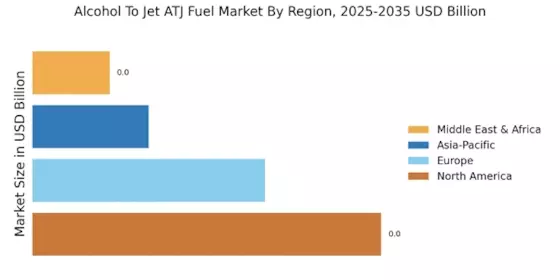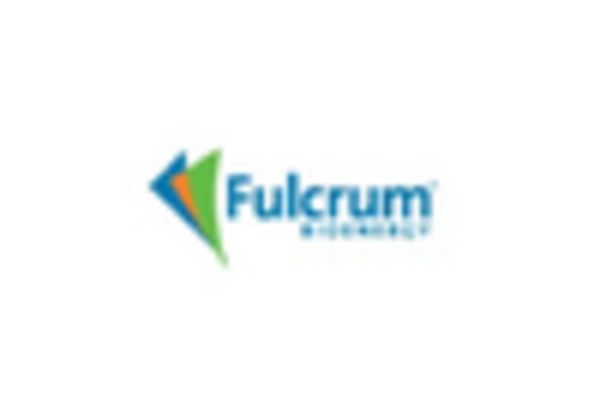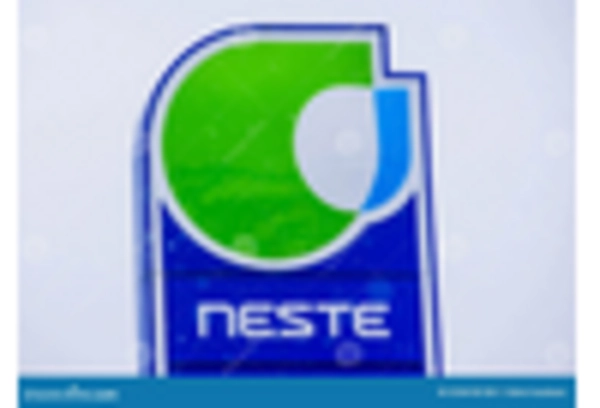Investment in Research and Development
Investment in research and development is a pivotal driver for the Alcohol To Jet Atj Fuel Market, as stakeholders seek to enhance fuel performance and reduce production costs. Increased funding from both public and private sectors is facilitating the exploration of new feedstocks and production methods. This financial commitment is essential for overcoming existing technological barriers and achieving scalability in production. Recent reports suggest that R&D investments in sustainable aviation fuels could reach billions of dollars over the next few years, indicating a strong belief in the potential of Alcohol To Jet Atj fuels. As innovations emerge from these investments, the Alcohol To Jet Atj Fuel Market is likely to benefit from improved fuel properties, making it a more attractive option for airlines and other stakeholders in the aviation sector.
Regulatory Support for Sustainable Fuels
The Alcohol To Jet Atj Fuel Market is experiencing a surge in regulatory support aimed at promoting sustainable aviation fuels. Governments are implementing policies that encourage the use of alternative fuels, which could potentially reduce greenhouse gas emissions from the aviation sector. For instance, mandates for blending renewable fuels into conventional jet fuel are becoming more prevalent. This regulatory environment not only incentivizes investment in Alcohol To Jet Atj technologies but also fosters innovation within the industry. As a result, companies are likely to increase their production capacities to meet these new standards, thereby expanding the market. Furthermore, the alignment of national and international regulations may create a more cohesive framework for the Alcohol To Jet Atj Fuel Market, enhancing its growth prospects in the coming years.
Technological Innovations in Fuel Production
Technological advancements are playing a crucial role in the Alcohol To Jet Atj Fuel Market, enhancing the efficiency and cost-effectiveness of fuel production processes. Innovations such as improved fermentation techniques and advanced catalytic processes are enabling producers to convert biomass and waste materials into jet fuel more efficiently. These developments not only lower production costs but also increase the yield of fuel from raw materials. As technology continues to evolve, it is likely that the Alcohol To Jet Atj Fuel Market will see a diversification of feedstocks, including agricultural residues and municipal solid waste. This diversification could lead to a more resilient supply chain and reduce dependency on traditional fossil fuels, thereby positioning the Alcohol To Jet Atj Fuel Market as a key player in the transition to a more sustainable aviation industry.
Rising Demand for Sustainable Aviation Solutions
The Alcohol To Jet Atj Fuel Market is witnessing an increasing demand for sustainable aviation solutions, driven by both consumer preferences and corporate sustainability goals. Airlines are under pressure to reduce their carbon footprints, leading to a heightened interest in alternative fuels. Recent studies indicate that a significant percentage of travelers are willing to pay a premium for flights utilizing sustainable fuels. This shift in consumer behavior is prompting airlines to explore partnerships with Alcohol To Jet Atj fuel producers to secure a reliable supply. The market for sustainable aviation fuels is projected to grow substantially, with estimates suggesting a compound annual growth rate of over 30% in the next decade. This trend indicates a robust opportunity for the Alcohol To Jet Atj Fuel Market to expand its influence within the aviation sector.
Collaborative Partnerships Across the Supply Chain
Collaborative partnerships are increasingly shaping the Alcohol To Jet Atj Fuel Market, as stakeholders recognize the need for a unified approach to fuel production and distribution. Airlines, fuel producers, and technology developers are forming alliances to streamline the supply chain and enhance the availability of sustainable fuels. These collaborations can lead to shared resources, knowledge transfer, and reduced costs, ultimately benefiting the entire industry. For instance, joint ventures between airlines and biofuel producers are becoming more common, allowing for the establishment of dedicated supply lines for Alcohol To Jet Atj fuels. Such partnerships not only facilitate market entry for new players but also strengthen the overall infrastructure supporting the Alcohol To Jet Atj Fuel Market, paving the way for broader adoption of sustainable aviation fuels.


















Leave a Comment